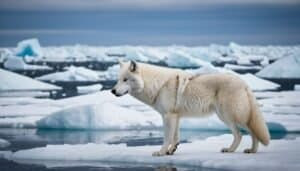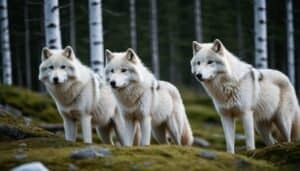Introduction
The conservation of Arctic wolves has garnered significant attention from the international community due to the unique challenges these animals face
This article explores the primary threats to Arctic wolves, including natural predators, human activities, and climate change. It delves into international and national policies designed to protect these majestic creatures, highlighting key agreements, the role of the United Nations, and national legislation
Additionally, we examine the vital contributions of NGOs and community efforts in Arctic wolf protection, focusing on major organizations, community-based initiatives, and funding programs
Finally, the article discusses various conservation strategies and shares success stories, emphasizing protected areas, breeding programs, and public awareness campaigns
Primary Threats to Arctic Wolves
Arctic wolves face numerous threats that jeopardize their survival. These threats can be broadly categorized into natural predators and competition, human activities and habitat loss, and the pervasive effects of climate change
Natural Predators and Competition
Arctic wolves, also known as white wolves, inhabit the remote regions of the Arctic, where they are at the top of the food chain. Despite their status as apex predators, they face competition from other species
Predatory competition primarily comes from polar bears and other wolf packs. While adult wolves have few natural predators, pups are vulnerable to attacks from golden eagles and other wolves. This interspecies and intraspecies competition can impact wolf pack dynamics and access to food resources, especially during harsh winters when prey is scarce
Human Activities and Habitat Loss
Human activities significantly impact Arctic wolves, even in the remote regions they inhabit. Oil and gas exploration, mining, and road construction disrupt their natural habitat, leading to habitat fragmentation
This fragmentation reduces the wolves’ hunting grounds and forces them into closer contact with human populations, increasing the risk of human-wolf conflicts. Additionally, noise pollution from industrial activities can disturb wolf packs and interfere with their communication and hunting efficiency
Hunting and trapping, though less common today due to legal protections, still pose a threat in some regions. In certain areas, wolves are hunted for their fur or to protect livestock, despite their preference for wild prey
Conservation efforts are essential to mitigate these human-induced threats and ensure the survival of Arctic wolf populations
Climate Change Effects
Climate change is one of the most critical threats to Arctic wolves, profoundly altering their environment
The Arctic region is warming at approximately twice the global average rate, leading to significant changes in the landscape and ecosystem dynamics. Melting ice and snow affect the availability of prey, such as musk oxen and Arctic hares, which rely on specific conditions for foraging and survival
As the ice melts earlier in the spring and forms later in the fall, the hunting seasons for Arctic wolves are shortened, impacting their ability to find enough food
Furthermore, climate change leads to more frequent and severe weather events, such as storms and extreme cold spells, which can be detrimental to wolf packs, particularly to pups and older wolves. These changing conditions also force prey species to alter their migratory patterns and behavior, adding another layer of complexity to the wolves’ survival strategies
Research conducted by the World Wildlife Fund (WWF) in 2020 highlights the cascading effects of climate change on Arctic biodiversity, emphasizing the urgent need for global action to mitigate its impacts
The study points out that without significant intervention, the Arctic wolf population could face severe declines due to these compounded threats
International and National Policies for Arctic Wolf Conservation
Efforts to conserve Arctic wolves involve a combination of international agreements, the role of the United Nations, and national policies. These initiatives aim to protect the unique Arctic ecosystem and ensure the survival of its wildlife, including Arctic wolves
Key Agreements and Treaties
Several international agreements and treaties play a crucial role in Arctic wolf conservation. One of the most significant is the Arctic Council, established in 1996
The Council includes eight Arctic states: Canada, Denmark, Finland, Iceland, Norway, Russia, Sweden, and the United States. It focuses on promoting sustainable development and environmental protection in the Arctic region
The Council’s Conservation of Arctic Flora and Fauna (CAFF) working group specifically addresses issues related to biodiversity, including the protection of Arctic wolves
Another important treaty is the Convention on Biological Diversity (CBD), which was adopted in 1992. The CBD aims to conserve biological diversity, promote sustainable use of its components, and ensure fair sharing of benefits arising from genetic resources
Arctic wolves benefit from the CBD’s objectives, as the treaty encourages signatory countries to implement national strategies for biodiversity conservation
Additionally, the 1973 Agreement on the Conservation of Polar Bears also indirectly supports Arctic wolf conservation. While this agreement focuses on polar bears, its efforts to protect Arctic habitats and reduce human-wildlife conflicts also benefit other species, including Arctic wolves
Role of the United Nations
The United Nations plays a pivotal role in global wildlife conservation, including efforts to protect Arctic wolves. The United Nations Environment Programme (UNEP) leads various initiatives aimed at preserving biodiversity and mitigating climate change impacts
UNEP’s Arctic Program works to address environmental challenges in the region, promoting conservation measures that benefit Arctic wolves and other wildlife
The United Nations Framework Convention on Climate Change (UNFCCC) is another critical platform that influences Arctic wolf conservation. The Paris Agreement, adopted under the UNFCCC in 2015, seeks to limit global temperature rise and mitigate climate change impacts
By addressing the root causes of climate change, the Paris Agreement indirectly supports the preservation of Arctic ecosystems and the species that inhabit them, including Arctic wolves
National Policies and Legislation
Individual countries with Arctic territories have implemented national policies and legislation to protect Arctic wolves
In Canada, the Species at Risk Act (SARA) provides legal protection for endangered and threatened species, including the Arctic wolf. SARA aims to prevent the extinction of wildlife species, promote their recovery, and protect their critical habitats
In the United States, the Endangered Species Act (ESA) serves a similar purpose. While Arctic wolves are not currently listed under the ESA, the act’s provisions help protect critical habitats and address threats to various Arctic species, indirectly benefiting Arctic wolves
Norway’s Nature Diversity Act, adopted in 2009, focuses on preserving biodiversity and ensuring sustainable use of natural resources. This legislation provides a framework for protecting endangered species and their habitats, including those in the Arctic region
Russia, home to a significant portion of the Arctic wolf population, has enacted various conservation laws
The Russian Federation’s Law on Wildlife (1995) and the Law on Specially Protected Natural Areas (1995) establish legal protections for wildlife and their habitats. These laws support the conservation of Arctic wolves by creating protected areas and regulating human activities that could harm wildlife
Role of NGOs and Community Efforts in Arctic Wolf Protection
Non-governmental organizations (NGOs) and community efforts play a vital role in the conservation of Arctic wolves. These entities provide critical support through research, funding, advocacy, and on-the-ground conservation actions, often filling gaps left by government initiatives
Major Organizations Involved
Several prominent NGOs are actively involved in Arctic wolf conservation
The World Wildlife Fund (WWF) is a leading organization in this arena, focusing on habitat protection, climate change mitigation, and sustainable development in the Arctic. WWF’s Arctic Program works to preserve the delicate balance of the Arctic ecosystem, which is crucial for the survival of Arctic wolves
The Wildlife Conservation Society (WCS) also contributes significantly to Arctic wolf protection. WCS conducts extensive research on Arctic wolf populations, studying their behavior, ecology, and the impacts of environmental changes. This research informs conservation strategies and policy recommendations aimed at safeguarding Arctic wolves
Another key player is the International Union for Conservation of Nature (IUCN), which maintains the Red List of Threatened Species. The IUCN’s work includes assessing the conservation status of Arctic wolves and advocating for policies that address their conservation needs
The IUCN Polar Bear Specialist Group, while focused on polar bears, also contributes to broader Arctic conservation efforts that benefit Arctic wolves
Community-Based Conservation Efforts
Community-based conservation efforts are essential for the effective protection of Arctic wolves
Indigenous communities, who have lived in the Arctic region for millennia, possess invaluable knowledge about the local environment and wildlife. Their traditional practices and ecological understanding are crucial for developing sustainable conservation strategies
In Canada, the Inuit Tapiriit Kanatami (ITK), a national organization representing Inuit interests, collaborates with conservation groups to protect Arctic wildlife, including wolves. By integrating traditional knowledge with scientific research, the ITK helps create effective conservation plans that respect both cultural heritage and ecological needs
Similarly, in Russia, the Association of Indigenous Peoples of the North, Siberia, and the Far East (RAIPON) works to protect the rights and lands of indigenous communities. RAIPON’s efforts include advocating for the sustainable management of natural resources and the protection of wildlife habitats, which indirectly support Arctic wolf conservation
Funding and Support Programs
Funding is a critical component of successful conservation initiatives. NGOs often provide essential financial resources to support research, habitat protection, and community engagement programs
For instance, the Global Environment Facility (GEF) partners with various NGOs to fund conservation projects in the Arctic region. The GEF’s projects aim to enhance biodiversity, mitigate climate change impacts, and support sustainable livelihoods for local communities
The Arctic Funders Collaborative, a coalition of philanthropic organizations, focuses on funding initiatives that address the environmental and social challenges facing the Arctic. By supporting NGOs and community-based projects, the Collaborative helps implement effective conservation strategies for Arctic wolves and other wildlife
Crowdfunding platforms and public donations also play a significant role in financing conservation efforts
Campaigns led by NGOs, such as WWF and WCS, often rely on public support to raise awareness and funds for specific projects. These grassroots funding efforts enable NGOs to carry out essential conservation work that might not be possible through government funding alone
Conservation Strategies and Success Stories
Effective conservation strategies and notable success stories highlight the ongoing efforts to protect Arctic wolves. These strategies encompass the establishment of protected areas, breeding programs, and public awareness campaigns, all of which contribute to the preservation and recovery of Arctic wolf populations
Protected Areas and Reserves
Establishing protected areas and reserves is one of the most effective strategies for conserving Arctic wolves
These areas provide a safe habitat where wolves can live and hunt without the threat of human interference. Protected areas also help maintain the integrity of the Arctic ecosystem, which is crucial for the survival of various species, including Arctic wolves
In Canada, the establishment of the Quttinirpaaq National Park on Ellesmere Island is a significant step towards Arctic wolf conservation. This remote park covers over 37,775 square miles and offers a pristine habitat for Arctic wolves and other wildlife
The park’s isolation and strict protection measures ensure minimal human impact, allowing wildlife populations to thrive
Russia’s Wrangel Island, a UNESCO World Heritage Site, is another critical habitat for Arctic wolves. This protected area supports a diverse range of Arctic wildlife and serves as an important breeding ground for wolves
Conservation efforts on Wrangel Island focus on monitoring wolf populations and protecting their habitat from industrial activities
Breeding Programs
Breeding programs play a crucial role in the conservation of endangered species, including Arctic wolves. These programs aim to maintain genetic diversity and increase population numbers, ensuring the long-term survival of the species
Captive breeding programs, such as those run by the International Wolf Center, focus on breeding Arctic wolves in controlled environments. These programs not only help boost population numbers but also provide valuable insights into wolf behavior and genetics
Wolves bred in captivity can be reintroduced into the wild to strengthen existing populations and enhance genetic diversity
The Yellowstone Wolf Recovery Program in the United States serves as an inspirational model for Arctic wolf conservation. Although focused on gray wolves, the program demonstrates the effectiveness of captive breeding and reintroduction strategies
Since its inception in 1995, the program has successfully restored wolf populations in Yellowstone National Park, leading to a healthier and more balanced ecosystem. The lessons learned from this program can be applied to Arctic wolf conservation efforts
Public Awareness Campaigns
Public awareness campaigns are essential for garnering support and funding for Arctic wolf conservation. These campaigns aim to educate the public about the importance of preserving Arctic wolves and their habitat, as well as the broader implications of biodiversity loss and climate change
Organizations like WWF and the Wildlife Conservation Society (WCS) run extensive awareness campaigns to highlight the plight of Arctic wolves
These campaigns use various media platforms, including social media, documentaries, and educational programs, to reach a wide audience. By raising awareness, these organizations can mobilize public support and drive policy changes that benefit Arctic wolf conservation
The #SaveOurWolves campaign by the Center for Biological Diversity is a notable example of a successful public awareness initiative. This campaign focuses on protecting wolves across North America, including Arctic wolves, by advocating for stronger legal protections and promoting coexistence strategies
The campaign has garnered widespread support and has led to increased funding and policy changes in favor of wolf conservation
Success Stories
Several success stories demonstrate the positive impact of conservation efforts on Arctic wolf populations
For instance, the establishment of protected areas in Canada and Russia has led to stable or increasing wolf populations in these regions. These protected areas provide a safe haven for wolves, ensuring they have access to prey and minimal human disturbance
The reintroduction of wolves in Yellowstone National Park serves as a broader success story for wolf conservation. The program’s success in restoring ecological balance and improving biodiversity highlights the potential for similar initiatives to benefit Arctic wolves
Lessons learned from Yellowstone can be applied to Arctic regions, emphasizing the importance of habitat protection, genetic diversity, and public support
Conclusion
The conservation of Arctic wolves is a multifaceted endeavor that requires international collaboration, national policies, the involvement of NGOs, and community engagement. These efforts are crucial for addressing the significant threats posed by natural predators, human activities, habitat loss, and climate change
International agreements and treaties, such as those facilitated by the Arctic Council and the United Nations, provide a framework for coordinated action. National policies in countries like Canada, the United States, and Russia establish legal protections that help safeguard Arctic wolf populations and their habitats. NGOs and community-based initiatives play an indispensable role in funding, research, and implementing conservation strategies on the ground
Successful conservation strategies include the creation of protected areas, which offer a refuge for Arctic wolves and help maintain the delicate balance of the Arctic ecosystem. Breeding programs contribute to maintaining genetic diversity and bolstering wolf populations. Public awareness campaigns are vital for educating the public and garnering support for conservation efforts
Despite the challenges, there have been notable successes in Arctic wolf conservation
Protected areas in Canada and Russia have led to stable or increasing wolf populations, and public awareness campaigns have mobilized support and driven policy changes. The lessons learned from these successes, along with continued efforts and adaptive strategies, provide a path forward for ensuring the long-term survival of Arctic wolves
In summary, the conservation of Arctic wolves demands a comprehensive and collaborative approach. By addressing the various threats they face and implementing effective conservation strategies, we can help preserve these majestic creatures and the unique Arctic environment they inhabit










